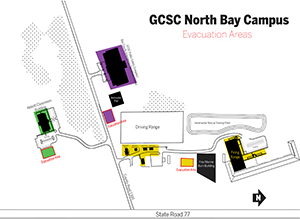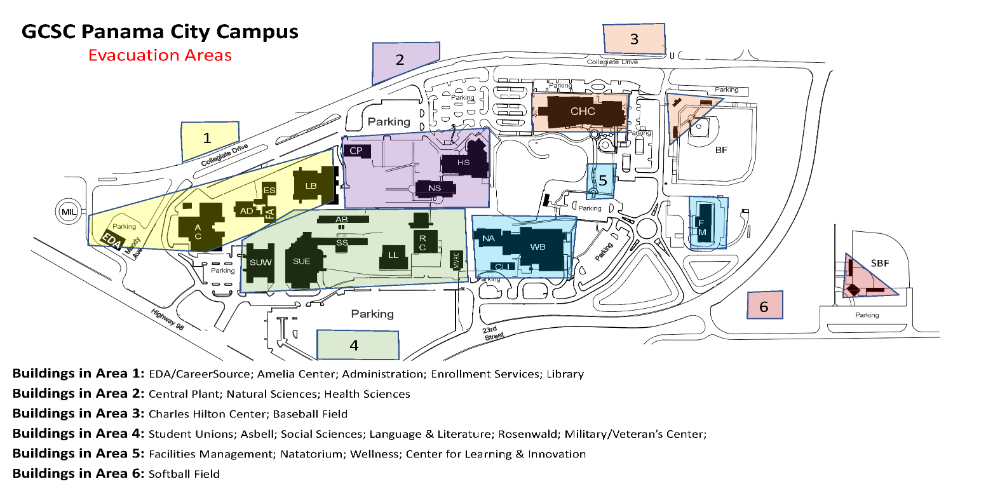Emergency Response
Depending on the specific situation, the emergency response of both those on GCSC campus and those responding to the campus may differ. The links on this page are intended to give you a basic guideline of what to do. As always, stay calm and be aware of your surroundings in the event that the unfolding situation requires you to adjust your normal response to the incident taking place.
When it is safe to return to your building, classrooms or vehicles, the “ALL CLEAR” will be given by designated personnel. Do not leave the designated safety areas unless instructed to do so as this could create another potentially dangerous situation for you and for others.
INCLEMENT WEATHER:
Florida’s weather can vary drastically throughout the year from cold winter storms to devastating hurricanes in the warmer months. Although hurricanes can be disastrous for all of us, the advantage of their slow movement allows time to prepare for those storms. Unfortunately, there are other weather systems that we must deal with such as tornadoes, waterspouts, strong winds or thunderstorms with lightning.
Tornadoes and water spouts (tornadoes formed over bodies of water) are cyclonic wind storms capable of extreme damage to structures and injury or death to persons. Due to their quick formation and unpredictable nature, tornadoes can appear with little or no warning. If faced with being in the path of a tornado, there are some steps you can take to reduce your risk of injury or death.
- Move to the interior of a building away from windows and doors.
- Crouch or kneel near interior walls and protect your head with your arms.
- If outside and you cannot make it to a building, find low lying areas such as drainage ditches and lie as flat as possible with your head protected.
- If driving on the roadway, do not try to outrun a tornado as they can move very quickly. Instead, look for an overpass or bridge structure that you can get under. Preferably you should attempt to get under the bridge or overpass in the area where the top roadway and the support structure meet.
- Be cautious of downed power lines and stay as far away from them as possible.
Thunderstorms are a very common occurrence here in the Panhandle given our warm weather and proximity to the Gulf of Mexico. Dangers included in severe thunderstorms can involve high winds, heavy rains and lightning. In most circumstances, thunderstorms are tracked and notification can be made with enough time to prepare. However, some storms form quickly and may require an emergency response on your behalf. Similar to your response to tornadoes.
- Move inside buildings and avoid windows and doors.
- If unable to get to a building, avoid tall items such as trees and utility poles as these items are more prone to lightning strikes.
- If driving on the roadway and safe to do so, pull over and remain in your vehicle until the storm passes.
- Be aware of high winds which may create projectiles from items the wind picks up.
- Be cautious of downed power lines and stay as far away from them as possible.
FIRE:
One of the most common disasters in the U.S. is fires which are capable of causing tremendous damage to property and loss of life. Fires are a rapidly changing incident that can spread quickly before resources arrive to combat it. Keep in mind that because fires can be unpredictable, you may have to alter your evacuation plan to avoid the dangers it creates. Response to fire should be the same whether you can see flames, smell smoke or simply hear the fire alarm sounding.
- Take the safest exit route. If you must escape through smoke remember to crawl low under the smoke and keep your mouth covered. The smoke contains toxic gases, which can disorient you or, at worst, overcome you.
- Move to a designated safe area then call 9-1-1.
- Do not congregate in the parking lot or attempt to get into your vehicle and leave. The gathering of people or traffic can prevent Fire/Rescue from getting to the buildings where the fire is and can potentially threaten lives.
- If you can't get out, close the door and cover vents and cracks around doors to keep the smoke out. Call 9-1-1, say where you are and signal for help at the window with a light-colored cloth, flashlight or any other item that can clearly be seen from outside.
| Emergency Evacuation Areas | ||
|---|---|---|
 |
 |
 |
EXPLOSIONS:
Explosions can occur as a result of a criminal act, accident or during another emergency such as a fire. During the incident, it may be unclear as to what caused the explosion and until it can be determined there are few steps you should take.
- Unless otherwise specifically directed, follow the same steps you would during a fire
emergency. Evacuate the building, go to a safe location and call
9-1-1. - Once you’ve contacted 9-1-1, turn off your cell phones and any two-way radios that you are carrying. In the event of an intentional explosive device, this could reduce the risk of accidental detonation of any secondary devices.
- Follow the directions of emergency personnel and stay calm.
HAZARDOUS MATERIAL:
Hazardous materials (HAZMAT) incidents occur when toxic chemicals are spilled or toxic gases are leaked into the environment in large quantities. This can cause an immediate risk to the safety of those in the area. Some tips to remember are:
- If you witness a hazardous materials accident, stay calm and call 9-1-1.
- Carefully follow the instructions of emergency personnel and if you are asked to evacuate, do so immediately.
- If you cannot leave the building and you suspect that gas or vapors have entered the building, take shallow breaths through a cloth or towel.
- If you are caught outside during an incident, try to stay upstream, uphill and upwind — hazardous materials can quickly be transported by water and wind.
- If you are in a car, close windows and shut off the air conditioner/heater.
- Avoid contact with any spilled materials including liquids, airborne mist or solid chemical deposits.